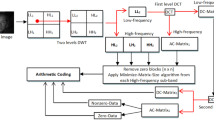Abstract
3D dynamic datasets compression still poses two challenges. One is high time cost due to growing data and complex computation of compression algorithms. The other is low compression factor because of complex motions of dynamic scenes and unknown motion equations. In this paper, composite rigid body construction for fast and compact compression of 3D dynamic datasets is proposed to solve these two problems. It accelerates the compression with a fast rigid body decomposition based on disjoint union, and avoids serial searching, comparing and merging of the rigid body decomposition. To increase the compression factor, composite rigid body is introduced with consideration of motion consistency among rigid bodies at different time periods. The results of the experiments show that our algorithm compresses dynamic datasets quickly and achieves a high compression factor.
Similar content being viewed by others
References
Rosen P, Popescu V. Simplification of node position data for interactive visualization of dynamic datasets. IEEE Trans Vis Comput Graph, 2012, 18: 1537–1548
Arikan O. Compression of motion capture databases. ACM Trans Graph, 2006, 25: 890–897
Lange R, Farrell T, Durr F, et al. Remote real-time trajectory simplification. In: Proceedings of 2009 IEEE International Conference on Pervasive Computing and Communications. Piscataway: IEEE, 2009. 1–10
Vries, G D, Someren M V. Clustering vessel trajectories with alignment kernels under trajectory compression. In: Proceedings of European Conference on Machine Learning and Knowledge Discovery in Databases. Berlin: Springer, 2010. 296–311
Alexa M, Mueller W. Representing animations by principal components. Comput Graph Forum, 2000, 19: 411–418
Karni Z, Gotsman C. Compression of soft-body animation sequences. Comput Graph, 2004, 28: 24–34
Sattler M, Sarlette R, Klein R. Simple and efficient compression of animation sequences. In: Proceedings of the 2005 ACM SIGGRAPH/Eurographics Symposium on Computer animation. New York: ACM, 2005. 209–217
Akhter I, Simon T, Khan S, et al. Bilinear spatiotemporal basis models. ACM Trans Graph, 2012, 31: 17–29
Guskov I, Khodakovsky A. Wavelet compression of parametrically coherent mesh sequences. In: Proceedings of the 2004 ACM Siggraph/Eurographics Symposium on Computer Animation, Switzerland, 2004. 183–192
Payan F, Antonini M. Wavelet-based compression of 3d mesh sequences. In: Proceedings of the Second International Conference on Machine Intelligence. Piscataway: IEEE, 2005. 32–40
Beaudoin P, Poulin P, van de Panne M. Adapting wavelet compression to human motion capture clips. In: Proceedings of Graphics Interface. New York: ACM, 2007. 355–364
James D L, Twigg C D. Skinning mesh animations. ACM Trans Graph, 2005, 24: 399–407
Landreneau E, Schaefer S. Poisson-based weight reduction of animated meshes. Comput Graph Forum, 2010, 29: 1945–1954
Kavan L, Sloan P P, O’Sullivan C. Fast and efficient skinning of animated meshes. Comput Graph Forum, 2010, 29: 327–336
Le B H, Deng Z. Smooth skinning decomposition with rigid bones. ACM Trans Graph, 2012, 31: 199–209
Le B H, Deng Z. Two-layer sparse compression of dense-weight blend skinning. ACM Trans Graph, 2013, 32: 258–266
Lengyel J E. Compression of time-dependent geometry. In: Proceedings of ACM Symposium on Interactive 3D Graphics. New York: ACM, 1999. 89–95
Shamir A, Pascucci V. Temporal and spatial level of details for dynamic meshes. In: Proceedings of ACM Symposium on Virtual Reality Software and Technology. New York: ACM, 2001. 77–84
Shlafman S, Tal A, Katz S. Metamorphosis of polyhedral surfaces using decomposition. Comput Graph Forum, 2002, 21: 219–228
Yang J H, Kim C S, Lee S U. Compression of 3-D triangle mesh sequences based on vertex-wise motion vector prediction. IEEE Trans Circuit Syst Video Technol, 2002, 12: 1178–1184
Ibarria L, Rossignac J. Dynapack: space-time compression of the 3D animations of triangle meshes with fixed connectivity. In: Proceedings of the ACM Siggraph/Eurographics Symposium on Computer Animation, Switzerland, 2003. 126–135
Zhang J, Owen C B. Octree-based animated geometry compression. Comput Graph, 2007, 31: 463–479
Author information
Authors and Affiliations
Corresponding author
Rights and permissions
About this article
Cite this article
Ma, Z., Wang, L., Zhang, B. et al. Fast and compact dynamic data compression based on composite rigid body construction. Sci. China Inf. Sci. 57, 1–19 (2014). https://doi.org/10.1007/s11432-014-5116-6
Received:
Accepted:
Published:
Issue Date:
DOI: https://doi.org/10.1007/s11432-014-5116-6




